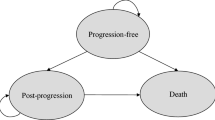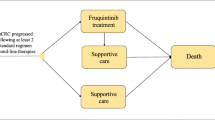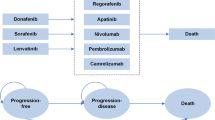Abstract
Background
In Japan, both incidence and mortality rates of cancers have continuously increased and medical costs are growing more rapidly than the overall economy of Japan. However, there is no consensus threshold for cost-effectiveness in medical care, and few studies have investigated cost-effectiveness of medical care in Japan. The present study was to determine the direct costs of molecular-targeting drugs that were recently approved in Japan through simple and quantitative calculations. Thus, we calculated an incremental cost-effectiveness ratio (ICER) and the cost per life-year gained (LYG) by using reported data from randomized clinical trials for various cancers.
Methods
Between 2008 and 2011, we reviewed seven molecular-targeting drugs that were approved for treatment of five cancers in Japan. These drugs included Bevacizumab, sorafenib, sunitinib, temsirolimus, Lapatinib, and panitumumab. Direct cost, ICER, and LYG of the drugs were estimated from the randomized phase III clinical trial data referred to in package leaflets. Effectiveness was defined as the prolongation of both median overall survival (OS) and progression-free survival (PFS). Costs were calculated as those of molecular-targeting drugs. Subsequently, ICER was based on 1-month increases in both OS and PFS periods and 1% increases in OS, and LYG was determined.
Results
Direct costs ranged from ¥724,804 ($9,060) to ¥1,506,628 ($18,833). ICERs of the drugs ranged from ¥724,804 ($9,060) to ¥1,506,628 ($18,833) for a 1-month increase in OS. For each month of PFS, ICERs ranged from ¥372,243 ($4,653) to ¥7,399,877 ($92,498). The costs of Bevacizumab and sorafenib for treatment of HCC per 1% increase in OS were ¥376,657 ($4,708) and ¥313,733 ($3,922), respectively. LYG ranged from ¥8,697,650 ($108,721) to ¥18,079,530 ($225,994).
Conclusions
Some molecular-targeting drugs are not cost-effective. Considering ethical and moral issues, we should establish economic endpoints to approve new drugs in Japan.
Similar content being viewed by others
Avoid common mistakes on your manuscript.
Background
In Japan, both incidence and mortality rates of cancers have continuously increased since the 1960s, with more than 357,000 cancer fatalities in 2011 [1]. The Ministry of Health, Labour and Welfare approves new anticancer drugs depending on the results of clinical trials. Medical costs are growing more rapidly than the overall economy of Japan. Japanese medical costs in 2010 came to ¥37,400 billion ($468 billion), ¥3,500 billion ($44 billion) of which was spent on cancer [2]. With increasing numbers of cancer patients, medical costs have continued to increase over recent years. However, there is no consensus threshold for cost-effectiveness in medical care, and few studies have investigated cost-effectiveness of medical care in Japan.
The primary objective of the present study was to determine the direct costs of molecular-targeting drugs that were recently approved in Japan through simple and quantitative calculations. Thus, we calculated an incremental cost-effectiveness ratio (ICER) and the cost per life-year gained (LYG) by using reported data from randomized clinical trials for various cancers.
Methods
Between 2008 and 2011, we reviewed seven molecular-targeting drugs that were approved for treatment of five cancers in Japan. These included Bevacizumab for non-squamous-cell and non-small-cell lung cancer (NSCLC), everolimus for metastatic renal cell carcinoma (RCC), sorafenib for advanced clear-cell RCC and hepatocellular carcinoma (HCC), sunitinib or temsirolimus for metastatic RCC, Lapatinib for locally advanced or metastatic breast cancer, and panitumumab for metastatic colorectal cancer. ICER and LYG of the drugs were compared using clinical data from randomized phase III clinical trials, which were referred to in package leaflets [3]. Medical effectiveness was defined as the prolongation of both median overall survival (OS) and progression-free survival (PFS). Medical costs were calculated from the costs of molecular-targeting drugs and the median or mean duration of treatments. In reports that did not present median or mean treatment duration, it was assumed that treatments continued until the occurrence of disease progression, and treatment duration was estimated accordingly. For simplicity, we assumed that average drug-dosing regimens were those appropriate for a 60-year-old male or female patient because the incidence of cancer is higher around this age range. Based on a report by the National Health and Nutrition Survey, body surface areas of male and female patients calculated from heights and weights of 165 cm and 61 kg and 152 cm and 54 kg were 1.7 m2 and 1.5 m2, respectively [4]. Drug costs were calculated for the year 2012 based on the medical fee given in the National Health Insurance drug price list [5]. Other direct and indirect costs were not included in this analysis. Subsequently, ICER, which is expressed as additional costs of new treatment per gain in clinical outcome, was calculated as follows.
ICER = Cost (A) - Cost (B)/effectiveness (A) - effectiveness.
(B) ICER was based on 1-month increases in both OS and PFS periods and 1% increases in OS. LYG was also calculated. US dollar costs were converted to Japanese Yen by multiplying by 80.
Findings
Among trials of the seven drugs, some compared molecular-targeting drugs with placebo or best supportive care (BSC), while others compared molecular-targeting drugs with previously established drugs. Representative phase III trials are summarized in Table 1. Trial 1 determined whether addition of Bevacizumab to paclitaxel and carboplatin improved survival of patients with metastatic non-squamous-cell and NSCLC [6]. Trials 2–4 evaluated everolimus for metastatic RCC and sorafenib for advanced clear-cell RCC and HCC and made comparisons with placebo-treated patients [7–9]. Trials 5 and 6 compared the efficacy of sunitinib or temsirolimus for metastatic RCC with that of interferon alpha [10, 11]. Trial 7 determined whether addition of Lapatinib to capecitabine improved survival of patients with HER2-positive, locally advanced, or metastatic breast cancers [12], and panitumumab was compared with BSC in patients with metastatic colorectal cancer [13]. Table 2 shows drug costs estimated by published studies. The direct costs of Bevacizumab, everolimus, sorafenib for RCC, sorafenib for HCC, sunitinib, temsirolimus, Lapatinib, and panitumumab were ¥3,013,255 ($37,666); ¥2,415,109 ($30,189); ¥3,581,292 ($44,766); ¥3,451,063 ($43,138); ¥6,153,336 ($76,917); ¥3,136,794 ($39,210); ¥1,787,170 ($22,340); and ¥1,151,092 ($14,389), respectively. OS and PFS data from the trials are summarized in Table 3.
In studies of Bevacizumab and Lapatinib [6, 12], cost differences (cost (A) - cost (B)) were presumed to be equivalent to the cost of Bevacizumab and Lapatinib because these studies estimated additional effect of these drugs to control arm. When control arms were placebo or BSC [7–9, 13], the cost (B) of the formulation was set at zero. In contrast, cost (B) in trials of sunitinib and temsirolimus [10, 11] reflected the cost of interferon alpha, which was calculated in the same way as that for
the molecular-targeting drug. With improved OS of 1 month, ICERs of Bevacizumab, sorafenib for HCC, and temsirolimus were ¥1,506,628 ($18,833); ¥1,053,321 ($13,167); ¥1,232,523 ($15,407); and ¥724,804 ($9,060), respectively. ICERs of Bevacizumab and sorafenib for HCC were ¥376,657 ($4,708) and ¥313,733 ($3,922) per 1% increase in OS. For each month of PFS, ICERs of Bevacizumab, everolimus, sorafenib for RCC or HCC, sunitinib, temsirolimus, Lapatinib, and panitumumab were ¥1,772,503 ($225,156); ¥1,150,052 ($14,376); ¥1,326,404 ($16,580); ¥915,546 ($11,444); ¥1,087,206 ($13,590); ¥372,243 ($4,653); and ¥7,399,877 ($92,498), respectively. LYGs with Bevacizumab, sorafenib for HCC, and temsirolimus were ¥18,079,530 ($225,994); ¥12,639,854 ($157,998); and ¥14,790,271 ($184,878)–¥8,697,650 ($108,720), respectively (Table 4).
Discussion
Substantial increase in the cost of cancer care is a global concern. The American Society of Clinical Oncology published guidelines that can be used to assess the costs of high quality cancer treatment [14]. Cost-effectiveness analyses compare ratios of incremental cost and incremental effectiveness of various strategies [15]. Quality-adjusted life years (QALYs) are commonly used to estimate the cost–utility of medical care. In the United States and United Kingdom, $50,000–100,000 and £20,000–30,000 per QALY are considered acceptable thresholds for cost-effectiveness [16]. A Japanese study on willingness to pay for one additional QALY suggests that ¥5,000,000 ($62,500) is an appropriate threshold [16]. However, few investigations examine medical cost-effectiveness, and consensus thresholds have not been established in Japan.
Determination of thresholds for cost-effectiveness in medical care is very difficult. Fojo et al. suggested that research studies with the ability to detect survival advantages of 2 months or less should only test interventions that cost less than $20,000 per course of treatment [17]. The present study shows that most molecular-targeting drug regimens cost more than ¥1,000,000 ($12,500) per 1-month gain in survival. Hence, these drugs have poor cost-effectiveness according to Fojo’s standard.
Among cancer treatments, radiation therapy has the greatest potential for cost-effectiveness in Japan [18]. The cost-effectiveness of carbon ion radiotherapy (CIRT) and conventional multimodal therapies was compared in Japanese patients with locally recurrent rectal cancers [19]. ICER per 1% increase in survival for CIRT was ¥6,428 ($80), much cheaper than that for Bevacizumab and sorafenib (¥376,657 and ¥313,733, respectively).
Molecular-targeting drugs offer novel and attractive strategies for improving patient survival and quality of
life after treatments. For example, Imatinib, a selective inhibitor of BCR-ABL tyrosine kinase, produces high response rates in patients with chronic-phase chronic myeloid leukemia and is considered a standard first line treatment [20]. On the other hand, molecular-targeting drugs are often only effective in a subset of patients. For example, anti-epidermal growth factor receptor antibodies should not be administered to colorectal carcinoma patients with KRAS mutations in codons 12 or 13 [21], although improved cost-effectiveness can be demonstrated for the remaining subset of patients.
Cost containment in oncology is a moral issue, and cost-effectiveness analyses are often recommended for determining how to best allocate resources. However, cost-effectiveness analyses often make prescriptions that are at odds with a sense of justice. That is, cost-effectiveness analyses reveal findings that maximize the average outcome but are indifferent to the statistical distribution of these outcomes. Hence, it is unethical to control medical costs with bureaucratic mechanisms [22].
As medical economic evaluations are relatively specific to individual health care systems, translation of the results of one economic study to different health care systems can be problematic [15]. Tsuchiya et al. performed cost-effectiveness analyses of consolidation therapy with Pemetrexed for NSCLC in Japan [23]. Their data indicated difficulties in use of consolidation therapy as the standard of care for Japanese patients who are covered by general medical insurance. In contrast, a US study revealed consolidation therapy to be cost-effective. We calculated the direct costs of molecular-targeting drugs in the Japanese medical treatment fee system and devised a simple, reliable, and quantitative method, allowing physicians to re-calculate and estimate cost-effectiveness using drug costs that are specific to local health care systems.
The lack of QALY analyses is a limitation of the present study. However, the reliability of QALY estimates are limited by methodological variations in measurements of utilities [24], and how well the QALY system actually reflects patient preferences is still debated [25].
Another limitation of this study is that we only calculated molecular-targeting drug costs and did not include other direct medical costs such as premedication and supportive therapy, direct non-medical costs such as transportation, and indirect costs such as work loss. However, use of molecular-targeting drugs could add costs associated with adverse events.
Conclusions
We have devised a simple and reliable method for estimating cost-effectiveness of novel chemotherapeutic agents and revealed poor cost-effectiveness of molecular-targeting drugs in Japan. Patient drug selections that are made with consideration of cost-effectiveness will save limited health care resources. Considering associated ethical and moral issues, economic endpoints for new drug approvals are required in Japan.
Abbreviations
- ICER:
-
Incremental cost-effectiveness ratio
- LYG:
-
Life-year gained
- NSCLC:
-
Non-small-cell lung cancer
- RCC:
-
Renal cell carcinoma
- HCC:
-
Hepatocellular carcinoma
- OS:
-
Overall survival
- PFS:
-
Progression-free survival
- BSC:
-
Best supportive care
- QALY:
-
Quality-adjusted life year
- CIRT:
-
Carbon ion radiotherapy
References
Center for Cancer Control and Information Services, National Cancer Center, Japan (in Japanese).http://www.ganjoho.jp/professional/statistics/statistics.html#01,
Medical cost statistics in Japan (in Japanese).http://www.e-stat.go.jp/SG1/estat/List.do?lid=000001101011,
Medical drug information (in Japanese).http://www.info.pmda.go.jp/psearch/html/menu_tenpu_base.html,
Ministry of Health, Labour and Welfare database (in Japanese).http://www.mhlw.go.jp/toukei/youran/indexyk_2_1.html,
Drug search ePHAMA (in Japanese).http://www.e-pharma.jp/index.html,
Sandler A, Gray R, Perry MC, Brahmer J, Schiller JH, Dowlati A, Lilenbaum R, Johnson DH: Paclitaxel-carboplatin alone or with Bevacizumab for non-small-cell lung cancer. N Engl J Med. 2006, 355 (24): 2542-2550. 10.1056/NEJMoa061884.
Motzer RJ, Escudier B, Oudard S, Hutson TE, Porta C, Bracarda S, Grünwald V, Thompson JA, Figlin RA, Hollaender N, Urbanowitz G, Berg WJ, Kay A, Lebwohl D, Ravaud A: RECORD-1 Study Group: Efficacy of everolimus in advanced renal cell carcinoma: a double-blind, randomised, placebo-controlled phase III trial. Lancet. 2008, 372 (9637): 449-456. 10.1016/S0140-6736(08)61039-9.
Escudier B, Eisen T, Stadler WM, Szczylik C, Oudard S, Siebels M, Negrier S, Chevreau C, Solska E, Desai AA, Rolland F, Demkow T, Hutson TE, Gore M, Freeman S, Schwartz B, Shan M, Simantov R, Bukowski RM: TARGET Study Group: Sorafenib in advanced clear-cell renal-cell carcinoma. N Engl J Med. 2007, 356 (2): 125-134. 10.1056/NEJMoa060655.
Llovet JM, Ricci S, Mazzaferro V, Hilgard P, Gane E, Blanc JF, de Oliveira AC, Santoro A, Raoul JL, Forner A, Schwartz M, Porta C, Zeuzem S, Bolondi L, Greten TF, Galle PR, Seitz JF, Borbath I, Häussinger D, Giannaris T, Shan M, Moscovici M, Voliotis D, Bruix J: SHARP Investigators Study Group.: Sorafenib in advanced hepatocellular carcinoma. N Engl J Med. 2008, 359 (4): 378-390. 10.1056/NEJMoa0708857.
Motzer RJ, Hutson TE, Tomczak P, Michaelson MD, Bukowski RM, Rixe O, Oudard S, Negrier S, Szczylik C, Kim ST, Chen I, Bycott PW, Baum CM, Figlin RA: Sunitinib versus interferon Alfa in metastatic renal-cell carcinoma. N Engl J Med. 2007, 356 (2): 115-124. 10.1056/NEJMoa065044.
Kwitkowski VE, Prowell TM, Ibrahim A, Farrell AT, Justice R, Mitchell SS, Sridhara R, Pazdur R: FDA approval summary: temsirolimus as treatment for advanced renal cell carcinoma. Oncologist. 2010, 15 (4): 428-435. 10.1634/theoncologist.2009-0178.
Geyer CE, Forster J, Lindquist D, Chan S, Romieu CG, Pienkowski T, Jagiello-Gruszfeld A, Crown J, Chan A, Kaufman B, Skarlos D, Campone M, Davidson N, Berger M, Oliva C, Rubin SD, Stein S, Cameron D: Lapatinib plus capecitabine for HER2-positive advanced breast cancer. N Engl J Med. 2006, 355 (26): 2733-2743. 10.1056/NEJMoa064320.
Van Cutsem E, Peeters M, Siena S, Humblet Y, Hendlisz A, Neyns B, Canon JL, Van Laethem JL, Maurel J, Richardson G, Wolf M, Amado RG: Open-label phase III trial of panitumumab plus best supportive care compared with best supportive care alone in patients with chemotherapy-refractory metastatic colorectal cancer. J Clin Oncol. 2007, 25 (13): 1658-1664. 10.1200/JCO.2006.08.1620.
Meropol NJ, Schrag D, Smith TJ, Mulvey TM, Langdon RM, Blum D, Ubel PA, Schnipper LE: American Society of Clinical Oncology Guidance Statement: The Cost of Cancer Care. J Clin Oncol. 2009, 27 (23): 3868-3874. 10.1200/JCO.2009.23.1183.
Earle CC, Coyle D, Evans WK: Cost-effectiveness analysis in oncology. Ann Oncol. 1998, 9 (5): 475-482. 10.1023/A:1008292128615.
Shiroiwa T, Sung YK, Fukuda T, Lang HC, Bae SC, Tsutani K: International survey on willingness-to-pay (WTP) for one additional QALY gained: what is the threshold of cost effectiveness?. Health Econ. 2010, 19: 422-437. 10.1002/hec.1481.
Fojo T, Grady C: How much is life worth: cetuximab, non-small cell lung cancer, and the $440 billion question. J Natl Cancer Inst. 2009, 101 (15): 1044-1048. 10.1093/jnci/djp177.
Takura T: Economic evaluation of stereotactic radiotherapy. (in Japanese). J Clin Exp Med. 2008, 226 (3): 247-252.
Mobaraki A, Ohno T, Yamada S, Sakurai H, Nakano T: Cost-effectiveness of carbon ion radiation therapy for locally recurrent rectal cancer. Cancer Sci. 2010, 101 (8): 1834-1839. 10.1111/j.1349-7006.2010.01604.x.
O'Brien SG, Guilhot F, Larson RA, Gathmann I, Baccarani M, Cervantes F, Cornelissen JJ, Fischer T, Hochhaus A, Hughes T, Lechner K, Nielsen JL, Rousselot P, Reiffers J, Saglio G, Shepherd J, Simonsson B, Gratwohl : Imatinib compared with interferon and low-dose cytarabine for newly diagnosed chronic-phase chronic myeloid leukemia. N Engl J Med. 2003, 348 (11): 994-1004. 10.1056/NEJMoa022457.
Allegra CJ, Jessup JM, Somerfield MR, Hamilton SR, Hammond EH, Hayes DF, McAllister PK, Morton RF, Schilsky RL: American Society of Clinical Oncology Provisional Clinical Opinion: testing for KRAS gene mutations in patients with metastatic colorectal carcinoma to predict response to anti-epidermal growth factor receptor monoclonal antibody therapy. J Clin Oncol. 2009, 27 (12): 2091-2096. 10.1200/JCO.2009.21.9170.
Sulmasy DP: Cancer care, money, and the value of life: whose justice? Which rationality?. J Clin Oncol. 2007, 25 (2): 217-222. 10.1200/JCO.2006.08.0481.
Tsuchiya T, Fukuda T, Furuiye M, Kawabuchi K: Pharmacoeconomic analysis of consolidation therapy with Pemetrexed after first-line chemotherapy for non-small cell lung cancer. Lung Cancer. 2011, 74 (3): 521-528. 10.1016/j.lungcan.2011.04.002.
McGregor M: Cost–utility analysis: Use QALYs only with great caution. Can Med Assoc J. 2003, 168 (4): 433-434.
Cressey D: Health economics: Life in the balance. Nature. 2009, 461 (7262): 336-339. 10.1038/461336a.
Acknowledgements
The authors would like to thank Enago (http://www.enago.jp) for the English language review.
Author information
Authors and Affiliations
Corresponding author
Additional information
Competing interests
The authors declare that they have no competing interests.
Authors’ contributions
TE designed the conception, collected and analyzed data, and drafted the manuscript. TO and TN helped to draft the manuscript. All authors read and approved the final manuscript.
Rights and permissions
Open Access This article is distributed under the terms of the Creative Commons Attribution 2.0 International License ( https://creativecommons.org/licenses/by/2.0 ), which permits unrestricted use, distribution, and reproduction in any medium, provided the original work is properly cited.
About this article
Cite this article
Ebara, T., Ohno, T. & Nakano, T. Quantitative medical cost-effectiveness analysis of molecular-targeting cancer drugs in Japan. DARU J Pharm Sci 21, 40 (2013). https://doi.org/10.1186/2008-2231-21-40
Received:
Accepted:
Published:
DOI: https://doi.org/10.1186/2008-2231-21-40




